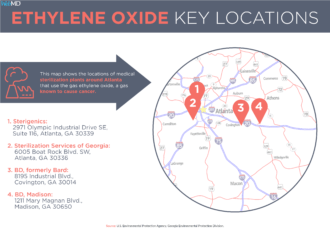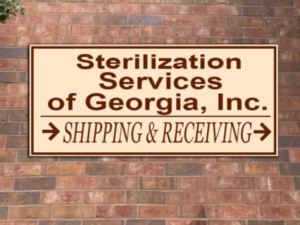Brenda Goodman is a senior news writer for WebMD. Andy Miller is editor and CEO of Georgia Health News.
A neighborhood west of Atlanta faces cancer risks that exceed what the government considers acceptable for airborne toxins, a study by the Georgia Environmental Protection Division (EPD) shows.
The neighborhood, Westchase at Sandtown, in southern Fulton County, sits about a half-mile southeast of Sterilization Services of Georgia, which uses ethylene oxide gas to sterilize medical products.

Based on the EPD’s modeling of the company’s reported emissions, average concentrations of ethylene oxide in the air at Westchase are higher than any other residential area that the agency has studied in the state.
“EPD believes that the lack of back vent controls at Sterilization Services of Georgia was the cause of these higher numbers,” said EPD spokesman Kevin Chambers in an emailed statement Wednesday.
Back vents are designed to blow ethylene oxide fumes away from any workers who open the door of a sterilization chamber after a sterilizing cycle.
With the permission of the federal Environmental Protection Agency (EPA), many sterilization facilities disconnected their back vents from pollution controls after a series of explosions rocked the industry’s facilities in the 1990s. Further study determined that the back vents were not to blame for the explosions, but many facilities never reconnected those vents to their pollution control equipment, and there was no law requiring them to do so.
A key lawmaker said the state’s findings should prompt more action.

“This facility in south Fulton should be forced to shut down until they can install the necessary equipment and prove that they are mitigating the risk to the community,” said state Rep. Erick Allen, a Democrat who represents Smyrna. Allen plans to propose legislation in the upcoming legislative session that would give the state new tools to monitor and regulate ethylene oxide, which the EPA says causes cancer.
Exposure to the gas over a long period of time has been linked to the development of breast and blood cancers such as leukemia and lymphoma.
Community protests and government scrutiny over ethylene oxide followed a report by WebMD and Georgia Health News last year that focused on the Georgia sterilizing plants using the chemical.
Much of the uproar has centered on two sterilizers in metro Atlanta, the facility run by Sterigenics in Cobb County, northwest of Atlanta, and a facility run by BD in Covington, east of Atlanta.
Less had been known about the potential impact of Sterilization Services of Georgia.
The facility sits in an industrial complex off Fulton Industrial Boulevard, just east of the Chattahoochee River.
Although the EPA tracks toxic emissions, the company stopped reporting its emissions to the agency in 2002. Because of that, the company was not included in the EPA’s latest air toxics assessment, published in August of 2018.
Since that report came out, the Georgia EPD has been doing its own modeling to determine risks from toxic emissions in the state. It has been working with the company – and using the company’s own reports about emissions — to understand how much ethylene oxide Sterilization Services is being released into the air.

The agency only recently completed its air modeling study for Sterilization Services, estimating that ethylene oxide levels exceed the state’s safe level at all three of the residential areas that are closest to the facility: Westchase, a subdivision called Tributary in Lithia Springs, and the Panther Riverside Park Apartments.
Average annual levels at Tributary were estimated to be 22 times higher than the state’s acceptable air level. Levels at the Panther Riverside Park apartments were about 3 times higher. (The state’s acceptable air level for ethylene oxide is very low and is stricter than the federal standard.)
The levels correspond to about 22 additional cases of cancer for every million people exposed at Tributary over the course of their lifetimes, and about 3 extra cases of cancer at Panther Riverside for every million people exposed over the course of their lifetime. These are considered to be small enough that they wouldn’t trigger additional government study.
It’s a different story for Westchase, however. Based on the state’s model, average levels were estimated to be 201 times higher than Georgia’s acceptable levels for ethylene oxide.
The EPA considers cancer risk from air toxins to be unacceptable when they exceed 100 cases of cancer for every million people exposed over the course of their lifetimes. The air concentrations modeled at Westchase are above that level. They represent about 200 extra cancers for every million people exposed to this level of ethylene oxide over the course of their lifetime (which is assumed to be 70 years).

Additional pollution controls were supposed to reduce that risk, but Sterilization Services missed a Dec. 31 deadline to install them.
In a consent order with the company, signed Tuesday, the state is levying fines of $3,000 a day.
If the company misses a Feb. 28 deadline to install the pollution controls, the state will require it to stop using ethylene oxide until it gets the pollution controls installed.
In addition to the state’s modeling study, Fulton County conducted air testing around Sterilization Services at five locations near the plant and at eight nearby schools.
The air samples were collected over 10 days in early October. Test results were presented to the Fulton County Board of Commissioners in December.
Nearly all samples showed levels of ethylene oxide that were above a federal safety standard.
Sterilization Services did not respond to a call for comment by our publication deadline.
The EPD says it is planning an information meeting for residents in the neighborhoods identified in the modeling study to discuss the recent enforcement action.

